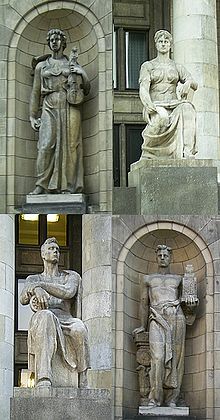Soviet-era statues are statuary art that figured prominently in the art of the Soviet Union. Typically made in the style of Socialist Realism, they frequently depicted significant state and party leaders, such as Joseph Stalin and Vladimir Lenin.

The construction of large monumental statues was a key part of Lenin's strategy of "Monumental propaganda" which proposed the use visual art to propagate revolutionary ideas. Such symbolism included other statues that were portrayals of realist allegorical figures in motion, figuratively striding forward into the new Soviet age, as well as Soviet role models, such as Nurkhon Yuldasheva.[1]
Statues of prominent socialist figures - particularly of Lenin - were mass-produced and installed in villages, towns and cities across the Soviet Union. After World War Two, the socialist states of the Eastern Bloc similarly produced a large number of statues.
- ^ National Encyclopedia of Uzbekistan (OʻzME). Birinchi jild. Tashkent, 2000